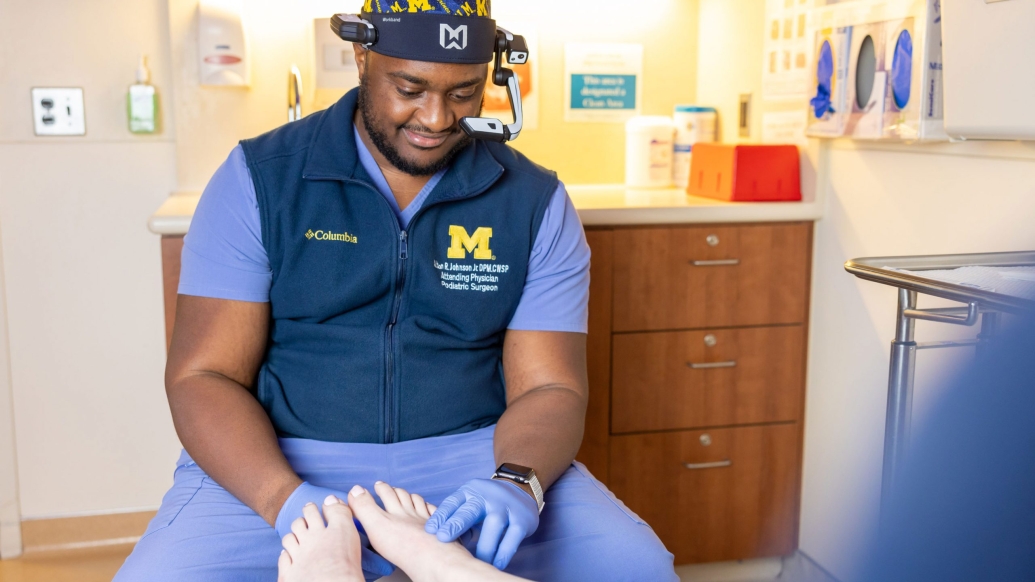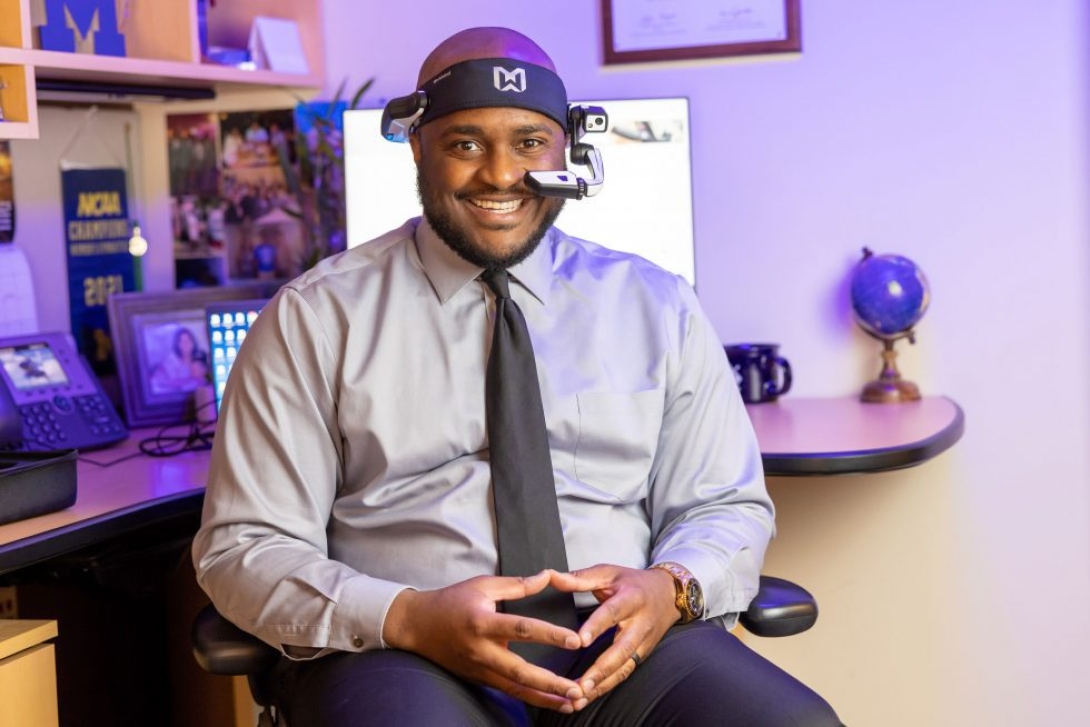An augmented reality tool teaches aspiring physicians how to perform diabetic foot examinations on patients
5:00 AM
Authors |

In his practice as a podiatrist, surgeon and wound care specialist, Alton R. Johnson Jr., D.P.M., sees many patients with diabetes who are seeking care for neuropathy, vascular complications and/or chronic wounds associated with diabetic foot.
Johnson, a clinical assistant professor in orthopedic surgery at the University of Michigan Medical School, is also an educator who works closely with medical students, residents and fellows from various areas across the institution.
“Because I treat such a high number of patients with diabetes, my rotation often hosts students from a broad range of departments, including internal medicine, family medicine and endocrinology. The one thing they all have in common is diabetic foot examinations. At some point, they’ll all need to know how to perform them,” he said.
This led Johnson to approach his curriculum in a more creative way, by incorporating the Michigan Virtual Examination for Skills Training, called Mi-VEST, into his teaching.
An innovative way of teaching
According to Johnson, this “health education innovation” helps students develop the right skills to treat individuals with diabetes by using an interactive augmented reality, or AR, device.
“I wanted to incorporate this virtual examination training into my curriculum so that I could teach individuals who are not podiatrists, like medical students or residents, how to perform diabetic foot exams,” said Johnson.
“It's kind of hard to get someone who's already practicing medicine to learn something entirely new, but when you have someone who's specifically attending your rotation to learn a new skillset, this becomes less challenging.”
Through one of his mentors, Johnson learned about a wearable device that incorporates AR to connect physicians to experts through telehealth settings.
He realized that this device, known as the Head Mounted Tablet, or HMT-1, could also be used for medical-related training and education.
Johnson then eagerly worked to acquire one for use in his clinic.
His initial idea involved creating a curriculum of first-person videos that students could watch to review procedures and surgeries.
“I started bringing the device with me to clinic and recording videos of myself using it,” he said.
“Everyone was looking at me and calling me a Marvel superhero, and that was pretty funny.”
Applying Extended Reality Technologies to Rounds (michiganmedicine.org)
The makers of the device, Hippo Virtual Care, later introduced Johnson to the virtual checklist feature, which allowed him to build a customized list within the device’s software that can walk each physician wearing it through the steps of the exam.
As the device user makes their way through the process, a visual checklist appears in the viewfinder connected to the head-mounted computer. This allows them to see both the virtual checklist in real-time, as well as the surrounding environment, which ensures that no steps are forgotten.
Expanding the curriculum
Johnson was thinking about piloting the device when a U-M medical student attending his rotation suggested that he look into the institution’s RISE program, which stands for research, innovation, scholarship and education.
While he was unfamiliar with the program, his interest was piqued, and he spent the next few hours exploring the program’s website and learning how he could better expand his curriculum through their offered services.
Once Johnson was eventually accepted into the program's Innovation Development Program, he started benefiting from it right away.
Like many faculty, staff and students at Michigan Medicine, Johnson keeps a busy schedule, and having things like protected time helped him focus on this project.
“Having that time carved out helped accelerate things that would have originally taken me six months to a year,” he said. “And instead, I was able to get project work accomplished in just one month.”
Through its monthly workshops, the program also helped Johnson focus on his overall vision and how best to improve usability of the device.
Free online tool expands anatomical science to the world | Michigan Medicine
He originally thought he would cover multiple podiatry topics, but the program helped him narrow his view on diabetic foot exams based on what students were asking about the most.

“I realized that you can’t go at the entire pie. Instead, you must go at the slices and take incremental steps to work your way up to your complete vision,” said Johnson.
“Before, I thought I could just do it all because that was the way it was always done, but RISE showed me how important it is to have a strategic plan.”
The program is also helping other innovators like Johnson make new connections.
“The program houses many great facilitators and networkers. If they don't know something, they will connect you with someone who does,” he said.
According to Johnson, getting connected with the XR Initiative through the Center for Academic Innovation helped him get additional support in areas like security, which is especially important as he begins to integrate patient information within this platform.
Johnson also says that he received assistance from a medical librarian who helped him conduct a literature review on using AR in education, adding that he recommends the program to his colleagues seeking support for their education-related ideas.
New Virtual Reality App Could Diminish MRI-Induced Claustrophobia (michiganmedicine.org)
“When people ask me about RISE, I always compare it to a medical health education think tank. You have a bunch of different academic-based professionals who try to think of ways to make unique ideas more scalable, while using the limited time that we have to execute them.”
Looking towards the future
While the Michigan Virtual Examination for Skills Training was originally designed strictly for physician-use, Johnson says that there's potential for interprofessional applications as well.
One idea involves training visiting nurses to use the device to assist with triaging homebound patients who are at risk of developing diabetic foot complications.
“This could help identify high-risk patients that are not able to get to clinics regularly or see their primary doctors, which may warrant an expedited referral or recommendation to a lower extremity specialist,” said Johnson.
And over time, Johnson hopes his project will help contribute to better care outcomes for patients, overall.
“My device is a train and treat model. You're training an individual or a student and you are also treating patients. The goal is to see if incorporating AR into medical education decreases morbidity and mortality. If so, then I think this project will be a huge success.”
To stay informed about opportunities and education in innovation happening at Michigan Medicine, join its community.
This story originally published in Michigan Medicine's internal publication Headlines.

Explore a variety of health care news & stories by visiting the Health Lab home page for more articles.

Department of Communication at Michigan Medicine
Want top health & research news weekly? Sign up for Health Lab’s newsletters today!





